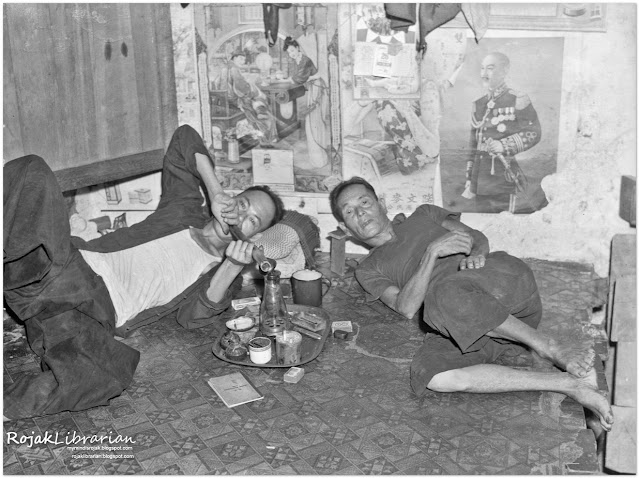Below is another great series of photos by Harrison Forman that when you do some research, gives insight to Singapore's dark past when there were still government regulated opium factories and opium dens. There are many well written and research work already on how this opium (seemingly harmless extracted from the poppy plant) affected and distorted trade, changed history, made some people rich and destroyed the lives of many more. (Do see some of the references below which i have provided link for if you want to do more in-depth reading). My focus for this article is trying to make sense and understand this series of pictures from the context of the time period it was taken (1941) were Chandu (opium in smokable form) was still legal, but regulated in Singapore.
 |
| Chandu (opium sold in tubes) sold at 26 cents from a legalised Opium retailer, location unknown (source: Harrison Forman Collection, University of Wisconsin-Milwaukee Libraries) |
 |
| Registration Card and Opium (Chandu) sealed in metal tubes (source: Harrison Forman Collection, University of Wisconsin-Milwaukee Libraries) |
 |
| Factory and factory workers packing opium into metal tubes (source: Harrison Forman Collection, University of Wisconsin-Milwaukee Libraries) |
 |
| Opium smokers (source: Harrison Forman Collection, University of Wisconsin-Milwaukee Libraries) |
In 1928, all smokers need to be registered and subsequently made compulsory. A permit card bearing the photograph of the smokers was introduced and by 1934, no more new applicants were accepted unless for medical purposes. The colonial government not only controlled the sale and distribution but also on its manufacturing. In 1930, a packing factory in Pasir Panjang hermetically sealed opium (two hoon worth) into small metal tubes that were affixed with the date and place of issue. The amended Chandu Revenue Ordinance thus made it stricter for illicit chandu to be distributed and purchased. Opium-smoking was finally outlawed in Singapore on 10 November 1943 during the Japanese Occupation. Post 1945, the war against the scourge of opium continued this time going underground. That is of course for another story all together.
Unfortunately, i am not able to figure where the location of the pictures are from.
References
NewspaperSG. (website). National Library Board, Singapore.
Chasing the Dragon: The Scourge of Opium. (website). BiblioAsia. National Library
Opium and Empire: Chinese Society in Colonial Singapore, 1800-1910
Carl A. Trocki. (website). Available from JSTOR
The Opium Problem in Singapore. (website).United Nations Office on Drugs and Crime
Comments
Post a Comment
Thank you for your comment. I can also be reached at rojaklibrarian@gmail.com